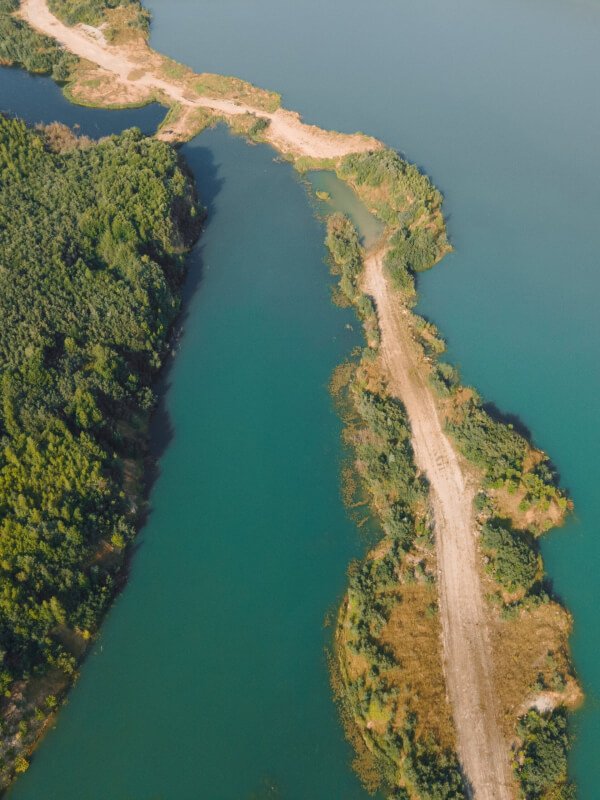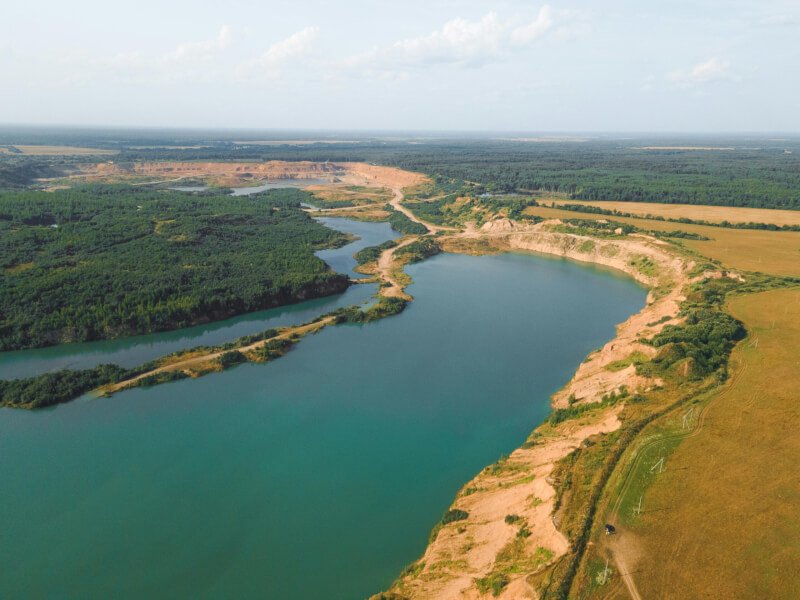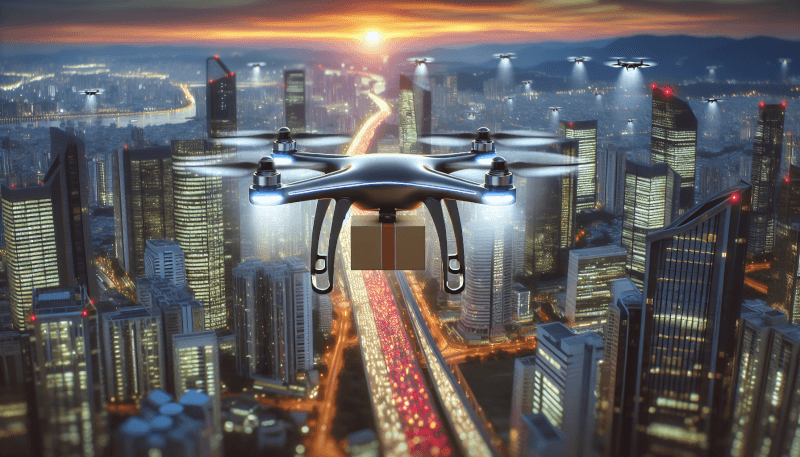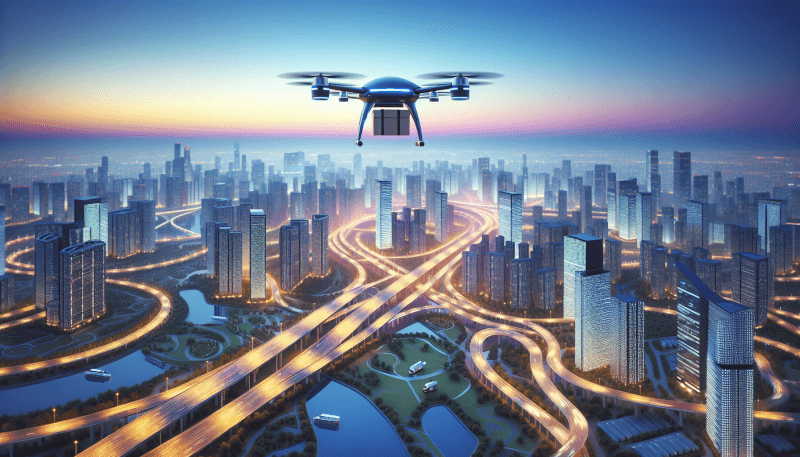Imagine a world where packages are effortlessly delivered to your doorstep within minutes, bypassing the congested streets below and soaring through the sky. This is the exciting future that awaits us with the rise of drone delivery services and urban air mobility. Rapid advancements in technology and the increasing demand for quicker, more efficient transportation solutions have paved the way for these innovations. In this article, we will explore the potential of drone delivery services and urban air mobility, and how they are poised to revolutionize the way we receive goods and navigate our cities. Get ready to witness a remarkable transformation in the way we experience transportation and logistics.
Potential Benefits of Drone Delivery Services
Drone delivery services offer several potential benefits that can revolutionize the way goods are transported and delivered.
Efficiency and Speed
One of the major advantages of drone delivery is its efficiency and speed. Drones can bypass traffic congestion and deliver packages directly to their destination, avoiding delays and improving delivery times. This can be especially beneficial for time-sensitive deliveries, such as medical supplies or emergency response situations.
Reduced Costs
Drone delivery services have the potential to significantly reduce costs compared to traditional delivery methods. With drones, there is no need for human drivers or vehicles, which can result in lower labor and transportation expenses. The cost savings can be passed on to consumers, making products more affordable and accessible.
Improved Accessibility
Drone delivery can improve accessibility, especially in remote or hard-to-reach areas. Drones can navigate challenging terrains and deliver goods to people living in rural and isolated communities. This can help bridge the gap in access to essential supplies and resources, making life easier for individuals who may otherwise struggle to obtain them.
Environmental Sustainability
Drone delivery services have the potential to promote environmental sustainability. By replacing traditional delivery vehicles with drones, carbon emissions can be minimized, leading to a decrease in air pollution. Additionally, drones are typically powered by electric batteries, reducing reliance on fossil fuels. This shift towards cleaner energy sources aligns with efforts to combat climate change and pursue a more sustainable future.
Technological Advancements in Drone Delivery
The advancement of technology plays a crucial role in the development and success of drone delivery services. Several key technological advancements have propelled the growth of this field.
Autonomous Navigation
Autonomous navigation is a critical technological advancement in drone delivery services. Drones equipped with state-of-the-art navigation systems can operate without direct human intervention, enabling them to navigate complex airspace and deliver packages accurately and efficiently. This autonomy allows for improved safety and reliability in delivery operations.
Sense and Avoid Technology
Sense and avoid technology is another important advancement that enables drones to detect and avoid potential obstacles or hazards during flight. With the help of sophisticated sensors and algorithms, drones can assess their surroundings and make real-time decisions to avoid collisions. This technology ensures the safety of both the drone and the people or objects it encounters.
Advanced Battery Technology
Battery technology is continually evolving, and this progress has greatly influenced the capabilities of drone delivery services. Improved battery technology allows drones to have longer flight times and increased payload capacities. This means that drones can carry larger and heavier packages, expanding the potential applications and efficiency of drone delivery.
Payload Capacity Improvements
Advancements in drone design and materials have led to significant improvements in payload capacity. Lightweight yet sturdy materials, such as carbon fiber, enable drones to carry heavier packages without compromising their maneuverability or flight performance. This increase in payload capacity allows for the delivery of a wider range of goods, including larger items that were previously impractical to transport via drones.

Regulatory Challenges and Solutions
While drone delivery services offer numerous benefits, there are several regulatory challenges that need to be addressed to ensure safe and responsible operations.
Airspace Regulations
Airspace regulations play a crucial role in governing the operation of drones. Establishing clear guidelines and rules for drone flights is essential to prevent conflicts with other aircraft and ensure safety. Regulatory bodies are working on creating comprehensive frameworks that define the permissible altitude, flight paths, and designated areas for drone operations.
Privacy Concerns
Privacy concerns are another important aspect that regulators need to address. As drones become more prevalent in urban landscapes, concerns about privacy invasion and unauthorized surveillance arise. Clear regulations and guidelines must be implemented to protect individuals’ privacy rights and ensure that drones are used responsibly and ethically.
Collision Risks and Safety Measures
Collisions between drones and other aircraft or objects pose a significant safety risk. To mitigate this risk, regulations should introduce mandatory safety measures such as geo-fencing, which restricts drones from entering specified areas, and the use of transponders to allow for better detection and tracking of drones in airspace.
Integration with Existing Transportation Systems
Integrating drone delivery services with existing transportation systems is another regulatory challenge. Coordination with airports, logistics centers, and other transportation hubs is essential to ensure seamless operations and minimize disruptions. Establishing collaborative frameworks that encourage communication and coordination between different stakeholders will be vital for successful integration.
Integration of Drones in Urban Air Mobility
The integration of drones in urban air mobility presents unique challenges that need to be addressed to unlock the full potential of this technology.
Urban Air Traffic Management
Managing the increased volume of air traffic in urban areas will be crucial for the safe and efficient operation of drone delivery services. Implementing robust urban air traffic management systems that can monitor and control drone movements will help prevent congestion and ensure smooth operations.
Infrastructure Development
The development of infrastructure to support drone delivery services is a key factor in their successful integration into urban areas. This includes the establishment of landing pads, charging stations, and dedicated transportation routes to facilitate efficient and reliable operations. Collaborative efforts between governments, private companies, and technology providers will be essential for infrastructure development.
Support from Local Governments
Support from local governments is crucial for the widespread adoption of drone delivery services. It is essential to create regulatory frameworks that promote innovation while ensuring safety and compliance. Local governments can also play a role in providing financial incentives and grants to encourage the implementation of drone delivery services, particularly in areas with limited access to goods and services.
Public Acceptance and Awareness
Public acceptance and awareness are instrumental in the successful integration of drones into urban air mobility. Educating the public about the benefits and safety measures associated with drone delivery services can help address concerns and build trust. Open dialogue and transparent communication between stakeholders, including drone operators, local communities, and regulatory bodies, are essential for fostering public acceptance and support.

Emerging Applications and Use Cases
Drone delivery services have the potential to revolutionize various industries and address unique challenges in different sectors.
Medical Supplies and Emergency Response
The delivery of medical supplies and emergency response services is one of the most promising applications of drone technology. Drones can transport critical medical supplies, such as medications, vaccines, blood, and organs, to remote or disaster-stricken areas quickly and efficiently. This ability to deliver life-saving resources in a timely manner can significantly improve emergency response capabilities and save countless lives.
Last-Mile Delivery
Last-mile delivery, which refers to the final leg of the delivery process from a distribution center to the destination, is a significant challenge for traditional logistics systems. Drones can overcome the limitations of conventional transport modes, bypassing traffic congestion and delivering packages directly to customers’ doorsteps. This efficient and cost-effective last-mile delivery option can enhance overall logistical efficiency and customer satisfaction.
Rural and Remote Area Accessibility
One of the most notable benefits of drone delivery services is their potential to improve accessibility in rural and remote areas. These regions often face challenges related to infrastructure limitations and long transportation distances. Drones can bridge this gap by providing a reliable and efficient mode of transportation for essential supplies, including food, medicine, and household goods.
Inspection and Surveillance
Drones have extensive applications in the field of inspection and surveillance. From monitoring critical infrastructure, such as power lines and pipelines, to conducting aerial surveys and surveillance operations, drones can offer a cost-effective and efficient alternative to traditional methods. The ability to access hard-to-reach or hazardous areas while minimizing human risk makes drone technology ideal for inspection and surveillance purposes.
The Role of Artificial Intelligence in Drone Delivery
Artificial Intelligence (AI) plays a crucial role in enhancing the capabilities and performance of drone delivery services.
Automated Route Optimization
AI algorithms can analyze vast amounts of data and optimize drone delivery routes based on various factors such as distance, weather conditions, and traffic patterns. By continuously learning and adapting, AI-powered systems can improve route efficiency, reduce delivery times, and minimize energy consumption.
Real-Time Data Analytics
Real-time data analytics enables drones to continuously gather and process information during flight. AI algorithms can interpret this data to make informed decisions and adjustments in real-time. This capability allows drones to react to unexpected events, such as changes in weather conditions or airspace restrictions, ensuring safe and efficient operations.
Machine Learning for Improved Flight Performance
Machine learning algorithms allow drones to learn from their flight experiences and optimize their performance over time. By analyzing flight data, drones can identify patterns and trends, enabling them to enhance flight stability, energy efficiency, and maneuverability. This continuous improvement in flight performance ensures reliable and safe delivery operations.
AI-Powered Decision-Making
AI-powered decision-making enables drones to make complex decisions autonomously. Drones equipped with AI systems can assess their surroundings, detect potential obstacles or risks, and make real-time decisions to ensure safe and efficient delivery operations. The ability to make split-second decisions based on AI algorithms enhances reliability and safety in drone delivery services.

Building Trust in Drone Delivery Services
Building trust in drone delivery services is crucial for their widespread adoption and acceptance. Several key factors contribute to establishing trust between operators, regulators, and the public.
Demonstrating Safety and Reliability
Drone operators must prioritize safety and demonstrate the reliability of their systems. Implementing rigorous testing and quality control measures, as well as adhering to industry standards and best practices, can ensure that drones operate safely and consistently. Regular maintenance, training programs for operators, and adherence to safety protocols are essential components of building trust in drone delivery services.
Transparent Communication
Transparent communication is vital in addressing concerns and building trust among stakeholders. Drone operators should proactively engage with local communities, regulatory bodies, and the public to provide accurate and up-to-date information about their operations. Open dialogue and transparency regarding safety measures, flight paths, and privacy protection can assuage fears and foster trust.
Effective Privacy Protection
Privacy protection is a significant concern in the context of drone delivery services. Operators must implement robust privacy measures, such as data encryption and secure storage, to ensure that personal information and captured imagery are adequately protected. Public awareness campaigns that highlight privacy protection protocols can help alleviate concerns and build trust.
Collaboration with Stakeholders
Collaboration with stakeholders, including local communities, regulatory bodies, and industry partners, is crucial for building trust in drone delivery services. By involving stakeholders in the decision-making process and seeking their input and feedback, operators can address concerns, incorporate valuable perspectives, and create a sense of shared ownership. Collaborative efforts contribute to the development of responsible and sustainable drone delivery operations.
Economic Impacts of Drone Delivery Services
Drone delivery services can have significant economic impacts, generating various opportunities and benefits.
Job Creation
The expansion of drone delivery services can create new job opportunities across different sectors. These include drone operators, maintenance technicians, data analysts, and support staff. Additionally, the growth of associated industries, such as drone manufacturing and infrastructure development, can further stimulate job creation and economic growth.
Increased Business Opportunities
Drone delivery services can open up new business opportunities and markets. Small businesses can access a wider customer base by utilizing drone delivery, and larger companies can streamline their supply chain and logistics operations. The efficiency and speed of drone delivery can enable businesses to offer faster shipping options and improve customer satisfaction.
Reduction in Transportation Costs
Traditional transportation methods often involve significant costs, such as fuel, maintenance, and labor. By replacing or supplementing traditional delivery methods with drones, transportation costs can be significantly reduced. This cost savings can be passed on to consumers, resulting in lower product prices, increased affordability, and improved market competitiveness.
Enhanced Productivity
With the introduction of drone delivery services, businesses can experience enhanced productivity and operational efficiency. Drones can expedite the delivery process, reduce transit times, and help streamline logistics operations. This increased efficiency allows businesses to allocate resources more effectively, focus on core competencies, and deliver goods to customers in a timely manner.

The Ethical and Social Implications
While drone delivery services offer numerous benefits, it is essential to consider the ethical and social implications that arise from their widespread adoption.
Privacy Concerns and Data Protection
The use of drones in urban areas raises privacy concerns, particularly regarding surveillance and data collection. Striking a balance between the benefits of drone technology and individual privacy rights is crucial. Implementing privacy regulations, anonymizing collected data, and providing individuals with control over their information can help alleviate privacy concerns and ensure responsible drone operations.
Noise Pollution and Visual Impact
Drones can generate noise and visual pollution, particularly in densely populated areas. Noise pollution can disrupt the peace and tranquility of neighborhoods, while the constant presence of drones in the sky may alter the visual landscape. Striving for quieter drone technologies and aesthetically pleasing designs can help minimize these impacts and integrate drones more harmoniously into urban environments.
Equitable Access to Drone Services
Ensuring equitable access to drone delivery services is vital. Steps must be taken to prevent a digital divide where certain communities or demographics may be excluded from benefiting from drone technology due to economic or geographic constraints. Governments and organizations should promote inclusivity and take proactive measures to ensure that drone services are accessible to all, regardless of socioeconomic or geographical factors.
Potential Job Displacement
As with any technological advancement, there is a potential for job displacement. The increased automation and efficiency of drone delivery services may reduce the need for certain roles in traditional logistics and transportation industries. It is crucial to address this challenge by providing retraining and job transition programs to ensure that individuals affected by automation can find new employment opportunities and thrive in the changing workforce.
Conclusion
Drone delivery services and urban air mobility hold tremendous potential to transform the way goods are transported, benefiting various sectors and addressing unique challenges. The efficiency, speed, and reduced costs offered by drones, coupled with technological advancements and regulatory frameworks, pave the way for a revolution in logistics and transportation. While challenges exist, such as regulation and building trust, the exciting possibilities ahead make it clear that drone delivery services are set to play a significant role in reshaping urban mobility and improving accessibility for communities worldwide. By embracing these advancements responsibly, we can create a future where aerial delivery becomes a seamless and integral part of our everyday lives.



